on Interior Transformations, Cox Economic Insight, Vitesco and Propulsion Systems, AI for Big Rigs and Much More
“Shy tech” for interiors. . .car loans v. house loans. . .about Vitesco and the development of tech. . .Pony.ai teams with Chinese truck maker. . .Chery building its version of Bell Labs. . .the ‘23 Honda HR-V. . .less-expensive fuel cells. . .ADAS terms, part 2. . .
#electronics #economics
Shy Tech & Other Interior Developments
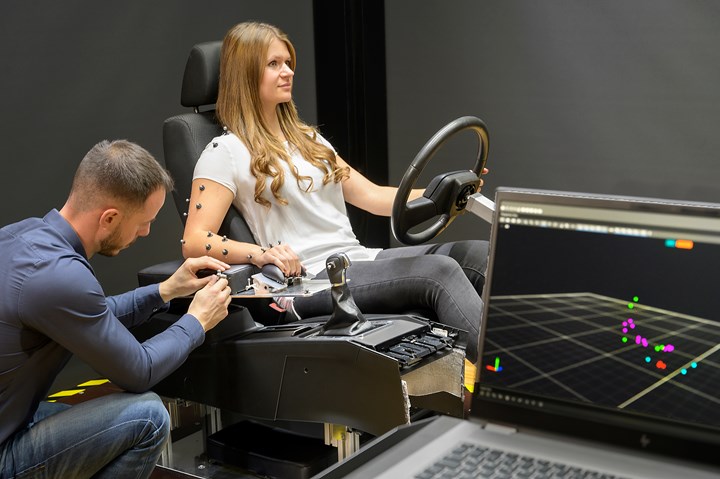
No, that woman is not undergoing vehicular acupuncture. She’s in the Grammer ErgoLab, where the functionality of center consoles is being evaluated. (Image: Grammer AG)
“When we entered center console business in the early 1990s with the first high-volume order for the VW Passat, the product was undergoing one of its first innovation thrusts,” says Jürgen Gerl, president Automotive Division at Grammer AG.
That mainly had to do with the center console becoming the repository of several functions, from cup holder to control panel.
Gerl says that another transition is underway as there is a move toward electric and autonomous vehicles:
“Many OEMs are focusing on a homely, lounge-like atmosphere, style, comfort, intelligent design and visibly sustainable surfaces in their new E-generations.”
- For the BMW iX, Grammer worked with BMW engineers on a center console that is produced with sustainable materials and addresses noise reduction.
- For the new VW Multivan it created a console that runs on rails from front to back and provides height adjustment.
Shy tech?
“We’re seeing a move away from highly complex operating concepts in favor of simplification, which is reflected in both design and functionality,” says Gerl.
Controls are integrated into “intelligent surfaces.” They are revealed when needed.
Reticent rather than obvious.
Things you don’t want shared
Although the pandemic put something of a pause on ride hailing, the numbers are beginning to increase.
Gerl: “In shared mobility vehicles, the hygiene aspect will paly an important role, which we address with smooth, easy-to-clean surfaces and seamless designs.”
Shy advantage
Presumably, the shy tech approach to embedded controls would help with the hygienic approach. A quick spray of Lysol on the surface rather than needing to wipe individual nobs.
>>>
Economically Speaking
“That higher rates will lead to lower new-vehicle sales is not a foregone conclusion. As the new market has shifted to become more concentrated in higher price points, the industry benefits from having higher income and higher credit quality buyers who are less negatively impacted by the current inflation trends. At this end of the credit spectrum, the limitation on transactions has been supply, and the limitation going forward is likely to be more about confidence than capability.”—Jonathan Smoke, chief economist, Cox Automotive, on the Fed’s increase of the target for Federal Funds Rate by 0.75%.
Smoke also explained:
“The term length of a loan determines the impact of a change in rates on the average payment. The longer the loan term, the greater the payment inflation. A 1-point change in a 30-year mortgage has a 12% impact on the average payment, all other factors equal. A 1-point change on a 6-year auto loan has a 3% impact on the average payment.”
As is often noted, the two most expensive things people generally buy are a house and a car.
Seems like the car is in a better financial space right now.
>>>
Sandy Stojkovski on Positioning for Performance

Sandy Stojkovski, CEO of Vitesco Technologies USA: “It’s a fierce, competitive market out there. Everyone is looking to secure their future during this technology transformation, so to win, you have to be a disruptor.” (Image: Vitesco)
This past January Vitesco Technologies announced it had won an order worth more than 1-billion euros from “a major North American car manufacturer” for 800-volt inverters that use silicon carbide technology. Depending on the timing of the exchange rate, that is >$900-million.
Literally a big deal.
And Vitesco says that in order to supply the inverters along with a power module, it will build them in North America in early 2025.
But then you stop and think “Vitesco Technologies”?
Sandy Stojkovski, CEO, Vitesco Technologies USA, describes the company as a “150-year-old startup.”
It had been part of Continental Corporation. It was spun off last year.
Although superficially it might seem that this was a move for Conti to divest itself of its internal combustion engine (ICE) operations, that is only part of it, as Stojkovski points out that the company has been in vehicular electrification since 2010 and that, for example, it is on generation four of its e-axle system.
Two operations
Yes, there is an ICE portion of Vitesco. And Stojkovski says that at almost the same time that Ford formed two distinct businesses, Ford Blue (ICE) and Ford Model e (electric, of course), Vitesco made a similar reorg, with one division focusing on combustion and the other electrification:
“We need both parts to succeed. The combustion side is funding the electrification side and both working together.”
The ICE age isn’t over yet. One thing that can be overlooked when there are billion-euro orders for inverters is that there will be tens of millions of combustion engines produced for years to come.
Stojkovski: “However, the growth is on the electrification side. The growth gets a lot of the headlines but there’s definitely a mature, robust set of volumes associated with combustion engines going into the future.”
She says that although “the vast majority of our R&D is on the electrification side,” she still sees the benefit of the cash generation being provided by combustion.
“There is some development on the combustion side but at a lower level compared to electrification. We have a stable full of very mature combustion products that are leading in the market.”
Stojkovski: “We need both parts to succeed.”
One of the reasons there is serious focus on the electrification side is because of the dynamic nature of what’s going on in that space: “You pay attention to things that are moving.”
Speed
And electrification is moving—fast.
She points out it is important for a company to develop thought leadership in advanced technology because it is no longer sufficient to react to an RFQ from an OEM:
“The electrification part of the business is moving way too quickly for someone to simply react to the signals from the OEMs. By the time you get an RFQ for something you have to have spent years developing it. You have to have an independent systems level understanding of the problems that are out there to be solved and have your point of view around the best solutions to get there.”
Stojkovski says that suppliers must be collaborative with its OEM customers: “We have to make sure that what we are independently developing is in alignment with something they might need.
“It is too capital-intensive to put a lot of work into something that may not see the light of day.”
Work in advance, but make sure what is being worked on is relevant.
Speed is something that some people might associate exclusively with the new OEMs. Stojkovski says that while those companies are executing “at a speed and agility others admire,” she adds, “I see a strong pull from what I’ll call our ‘mainstream customers’ who are seeking to be as fast—if not faster—because they are seeking leadership.”
This is a race with plenty of participants.
Transformative
Stojkovski makes a point that can be all too easily overlooked: “Technology transformations always require a business process transformation and an employee transformation.”
It can’t simply be a matter of switching the tech and leaving the other parts the same.
Other elements of the equation have to go with the tech transformation. You can’t leave the other parts the same or you miss the opportunity that can be realized.
“We put a lot of time and energy into enabling the people transformation to go with the technology transformation to go with the business model transformation and trying to fit that all together,” Stojkovski says.
Go fast. But go smart.
>>>
L4 Coming to Heavy Trucks in China
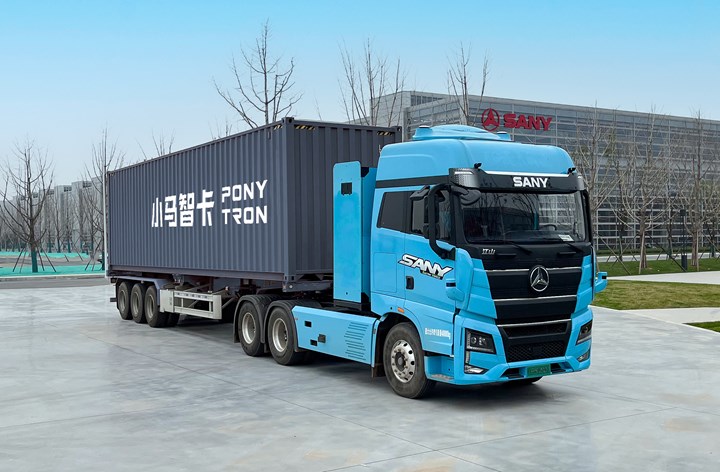
SANY and Pony.ai are collaborating on the development of autonomous trucks. (Image: Pony.ai)
“In 1986, Liang Wengen, Tang Xiuguo, Mao Zhongwu, and Yuan Jinhua founded Hunan Lianyuan Welding Material Factory in Lianyuan, which was officially renamed SANY Group five years later.”—from the SANY Global website
SANY Group now produces a wide array of construction machinery and equipment. According to the company it is “China’s number one heavy equipment manufacturer and the third largest heavy equipment manufacturer globally.”
From a welding firm to a major manufacturer.
All that in 36 years.
So why does this matter?
Going L4
SANY Heavy Truck and autonomous driving tech company Pony.ai announced they are collaborating on what they describe as “a world-leading autonomous truck brand.”
James Peng, Pony.ai’s co-founder and CEO, Pony.ai: “Integrating Pony.ai's core autonomous driving technologies with the capabilities of SANY enables our joint venture to create a successful intelligent truck and logistics ecosystem for L4 autonomous trucking.”
(L4 is considered “high automation,” with the vehicle being capable of self-driving though it may be necessary for a human to take control.)
Large numbers
The companies plan to begin mass production of the L4 trucks in 2024, eventually reaching an annual production rate of 10,000 units.
Apparently, there were 1.3-million heavy truck sales in China in 2021.
The Pony.ai autonomous driving controller is based on the NVIDIA DRIVE Orin system-on-a-chip.
The joint venture should certainly help drive the volume of the NVIDIA chips. According to NVIDIA, DRIVE Orin is “the choice AI compute platform for 20 of the top 30 passenger electric vehicle makers in the world.”
It is worth noting that SANY Heavy Truck says it was the leading supplier of “new energy heavy trucks in 2021 and the first half of 2022,” with new energy vehicles in China being plug-in hybrids, full electric vehicles and fuel cell electric vehicles.
Observations
- Odds are, the first substantial implementations of autonomous driving will be in trucking—not just in China, but globally
- Given the aggressive growth of SANY Group (you really need to see the photo on the company’s website [click that hotlink above] of where the company began to get a sense of this), this undertaking is worth keeping in mind
>>>
Chery’s Nod to an Amazing American Institution
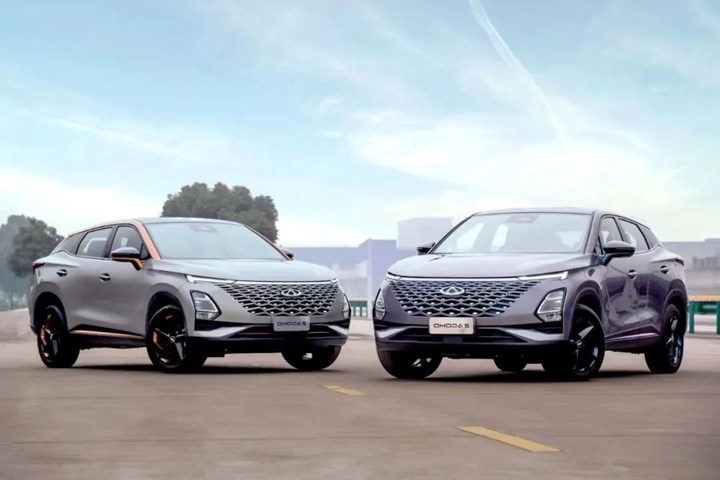
Chery, a Chinese OEM, has great goals when it comes to technology development. (Image: Chery)
While on the subject of Chinese NEV companies. . .
Chery Group, which operates Chery Automobile Manufacturing, announced the establishment of the Anhui New Energy Vehicle and Intelligent Connected Vehicle Industry Research Institute, in Anhui Province, China.
There are two primary functions:
- Automobile research, including power systems and autonomous driving
- Industrial tech incubation
What is striking about this is what Chery’s stated objective is:
“The construction of a series of special original laboratories to create a ‘Bell Lab’ belonging to Chery Automobile Manufacturing.”
And Chery has the following definition: “Bell Lab: The greatest human beings in the 20th century.” Those people include numerous Nobel laureates and Turing Award winners.
The striking thing about this is that it is rare to hear Bell Labs (now Nokia Bell Labs) cited by U.S. companies, even though it was the place from which developments ranging from the transistor to UNIX emerged.
And here is a Chinese OEM, which is rarely heard about, using that as their north star.
>>>
2023 Honda HR-V AWD EX-L
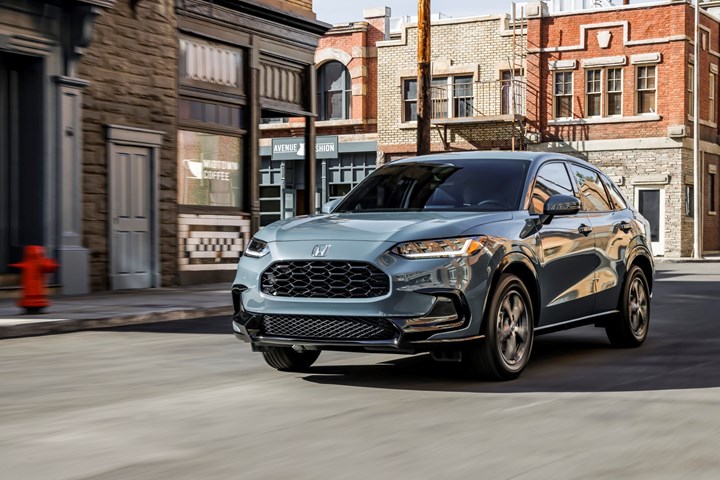
2023 Honda HR-V. Upscale exterior styling. Up-sized crossover. (Image: Honda)
The Honda HR-V first appeared in the U.S. market in 2015 as a 2016 model. That version of the subcompact crossover was actually the second generation of the vehicle; the first gen had gone into production in Japan in 1998 for domestic consumption, and later in Europe.
When the HR-V was launched in the U.S. market it was positioned as something both in size and price that was below the CR-V.
Thrifty
My recollection of driving that 2016 model was that it was. . .thrifty. Don’t get me wrong: it was fine. But it truly seemed to me to be primarily a small crossover for someone who couldn’t afford to get a bigger, better one, like the CR-V.
Or put another way: There was nothing aspirational about it. Nothing that would make one feel as though their purchase was because completely justified because the vehicle itself was good and worth it.
While this might seem as though I am damning with faint praise, that isn’t the point.
Appealing
Rather, it is to say that the 2023 HR-V, all new, really is something that people would look at and say, “Yes.”
It isn’t, “I wish I could get a CR-V but I have to settle for this.”
The ‘23 HR-V has what was once referred to as “Curb appeal.”
Although Honda is targeting what it calls “GenZennials” with the vehicle—after all, doesn’t everyone want to get a younger demographic in the showroom?—this is a crossover that is probably sized right for a wide variety of people, even those whose AARP card has miles on it.
Sized up
The ’23 is 179.8 inches long—or 9.4 inches longer than the previous generation. Yes, grown up.
And speaking of “up,” the vehicle is 63.4 inches high (or 63.8 inches for those who opt for the 18-inch alloys rather than the standard 17s).
Width is 72.4 inches.
The 104.5-inch wheelbase is just up 1.7 inches, and I suspect that may account for the fact that the numbers for cargo volume—24.4 cubic feet with rear seat up, 55.1 cubic feet with it folded—are just up a few tenths compared with the previous gen, despite the increased length.
The HR-V is powered by a 158-hp 2.0 liter in-line four, which is also used in versions of the Civic. Perhaps not entirely coincidentally, the HR-V platform is shared with the Civic. (The previous generation HR-V shared with the now-unavailable Honda Fit.)
In addition, the interior—the hexagonal mesh that is used for the air vents and stretches across the IP, in particular—also bring the Civic interior to mind.
There is model simplification for ’23 HR-V, with three trims—LX, Sport, EX-L—rather than four for the previous gen.
Value
The vehicle driven here the AWD EX-L (a.k.a., top-of-the-line) has a stickered MSRP of $28,950. The premium paint added $395, and so with the $1,245 destination and handling the whole thing came in at $30,590. Realize this has features ranging from leather-trimmed seats to automatic climate control, adaptive cruise to LED lights front and rear, a nine-inch color touch screen to lane-keeping assist, and more, so it is hard to see this as anything but something that someone would actually want.
>>>
The Hydrogen Future (?)
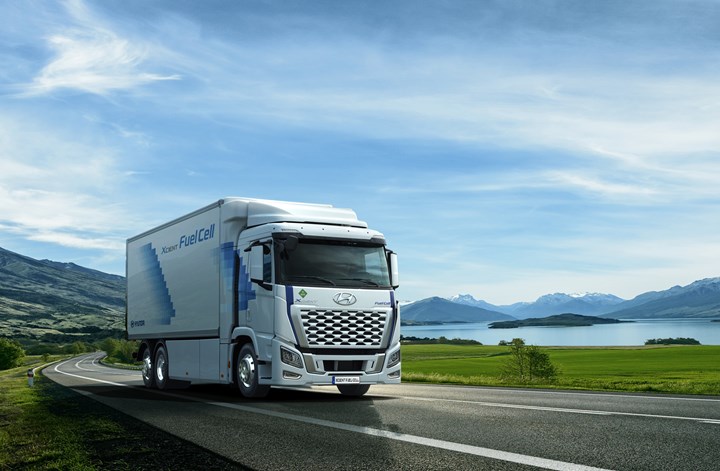
Hyundai XCIENT Fuel Cell heavy-duty trucks are in fleet operation in both Switzerland and Germany. (Image: Hyundai)
“We are currently working with most major OEMs with a serious fuel cell program.”
That’s Tom Stephenson, chairman and CEO, Pajarito Powder.
The powder in question is a material for catalysts used in fuel cell stacks.
(Somewhat) technically: the powder is interconnected mesoporous carbon. The platinum necessary for the fuel cell is deposited on that material. Given the interconnected mesoporious carbon characteristics, less platinum is needed for the catalyst than is otherwise the case.
Why is that important?
Well, given that even Tiffany’s is interested in sourcing platinum. . . .
Running some numbers
Stephenson says that the Department of Energy runs some numbers that look at the costs associated with the production of 500,000 fuel cell vehicles per year. (Yes, a breathtakingly large number that probably isn’t going to be realized anytime soon.)
Stephenson notes that 40% the cost of a fuel cell stack at that volume is the catalyst. “We can cut that cost in half. We can cut 20% of the entire cost of the fuel cell stack.”
He points out that presently a fuel cell system runs about $45-$46 per kilowatt. So for the sake of argument, take a vehicle with a 100 kW setup (a Hyundai Nexo has a 95-kW stack and the Toyota Mirai 128 kW, so this is a realistic number).
That’s $4,500.
Cutting some costs
Stephenson says to be cost competitive with an internal combustion engine the number needs to be closer to $2,500 to $3000.
If the Pajarito material can take 20% of the cost out, the $4,500 goes to roughly $3,500.
He adds that there are other impacts that the change in the catalyst can have, such as in the areas of humidification and start-up and shutdown.
“We can provide a material that is more robust at lower humidity, so you don’t need the humidifier.
“We can provide material solutions that are more robust and resistant to the degradation that occurs during the start-up and shutdown of the fuel cell, so you could potentially eliminate the power electronics currently being used to modulate voltage irregularities and prevent the degradation.”
Or said simply: “We can help take the overall cost down—dramatically.”
Hauling some freight
That said, Stephenson says that it will be in freight hauling trucks where there will be far more fuel cell use than in passenger vehicles.
“In general, the heavier the load and the longer the distance, the more you need to look at a fuel cell as a replacement for an internal combustion engine,” he says.
The size and weight of batteries that are needed to power Class 8 vehicles simply take up cargo room and reduce the distance that can be traveled. Hydrogen is simply more analogous in use to petroleum-based fuels.
He points out that Hyundai—which invested in Pajarito Powder last year—currently has 47 XCIENT Fuel Cell heavy-duty trucks operating in Switzerland and 27 more are going into operation in Germany.
Daimler, Volvo, Cummins and others are all working on hydrogen-powered rigs.
An impediment is infrastructure. But Stephenson says that 400 hydrogen fueling stations located on the major arterials could blanket the lower 48 U.S. states, making it possible for freight operators to put fuel cell trucks in operation.
>>>
ADAS Terms to Know (2)
The second tranche of terms defined by AAA, Consumer Reports, J.D. Power, National Safety Council, PAVE, and SAE International to make things more understandable:
COLLISION INTERVENTION
Automatic Emergency Braking Detects potential collisions with a vehicle ahead, provides forward collision warning, and automatically
brakes to avoid a collision or lessen the severity of impact. Some systems also detect pedestrians or other objects.
Automatic Emergency Steering
Detects potential collisions with a vehicle ahead and automatically steers to avoid or lessen the severity of impact. Some systems also detect pedestrians or other objects.
Lane Keeping Assistance Provides steering support to assist the driver in keeping the vehicle in the lane. The system reacts only when the vehicle approaches or crosses a lane line or road edge.
Reverse Automatic Emergency Braking
Detects potential collisions while in reverse gear and automatically brakes to avoid or lessen the severity of impact. Some systems also detect pedestrians or other objects.
-xxx-
RELATED CONTENT
-
On Automotive: An All Electric Edition
A look at electric vehicle-related developments, from new products to recycling old batteries.
-
Cobots: 14 Things You Need to Know
What jobs do cobots do well? How is a cobot programmed? What’s the ROI? We asked these questions and more to four of the leading suppliers of cobots.
-
on lots of electric trucks. . .Grand Highlander. . .atomically analyzing additive. . .geometric designs. . .Dodge Hornet. . .
EVs slowdown. . .Ram’s latest in electricity. . .the Grand Highlander is. . .additive at the atomic level. . .advanced—and retro—designs. . .the Dodge Hornet. . .Rimac in reverse. . .


.jpg;width=70;height=70;mode=crop)






